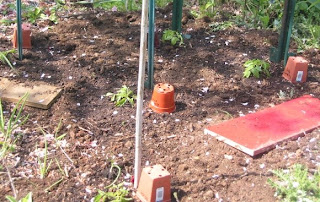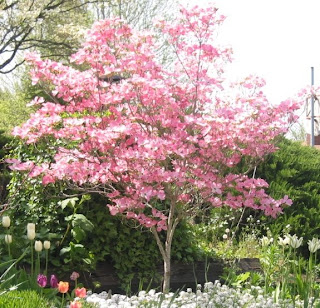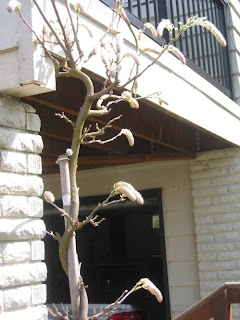Saturday, May 31, 2008
Overwintered and other Geranium (Pelargonium)
Here are some of the overwintered geraniums (Pelargonium). The most successful and easiest approach was to have them in containers and just leave the containers dry out in the garage for the winter. This is the "cheap+lazy" method since it really doesnt entail much effort, and results in nice good-sized plants by early summer.
 The variegated pelargonium was overwintered. It is just coming back into its own. The finely cut leaf pelargonium was just added. It is scented, citrus. The smaller flowers are sweet alyssum, probably coming up from seeds from ones that bloomed in the container last year.
The variegated pelargonium was overwintered. It is just coming back into its own. The finely cut leaf pelargonium was just added. It is scented, citrus. The smaller flowers are sweet alyssum, probably coming up from seeds from ones that bloomed in the container last year.
 So tell me, please - why do I need a peppermint scented pelargonium when I have peppermint-scented peppermint growing all over the place? Anyway, it does smell, strongly, like peppermint. This one is new, so is not an overwinter example.
So tell me, please - why do I need a peppermint scented pelargonium when I have peppermint-scented peppermint growing all over the place? Anyway, it does smell, strongly, like peppermint. This one is new, so is not an overwinter example.
 This wals also overwintered as above. This one is pine scented and it smells very much like pine. The scent is stong. Cool. Each time that I walk past it, I pinch off some more and smell it. The dark purple leaves are part of a Tradescantia pallida. This did well in other containers, using the dry-for-the-winter system. I was also surprised to see one poking up in the strawberry border, surviving the winter in ground. That is probably a fluke, this is really a tender tropical plant.
This wals also overwintered as above. This one is pine scented and it smells very much like pine. The scent is stong. Cool. Each time that I walk past it, I pinch off some more and smell it. The dark purple leaves are part of a Tradescantia pallida. This did well in other containers, using the dry-for-the-winter system. I was also surprised to see one poking up in the strawberry border, surviving the winter in ground. That is probably a fluke, this is really a tender tropical plant.
 This is another scented one. I forget the variety. It did not survive the totally dry method 2 winters ago - this was kept as a cutting over that winter. So this winter I kept it almost-dry in a cool sunny room. Also took a cutting, using the lazy-gardener's method of cut off a piece and stick into some potting soil and water like any other house plant. That worked too. I cleaned it up a bit, and stuck some cuttings in the ground or with other plants. If they grow, that's good. If not, nothing lost.
This is another scented one. I forget the variety. It did not survive the totally dry method 2 winters ago - this was kept as a cutting over that winter. So this winter I kept it almost-dry in a cool sunny room. Also took a cutting, using the lazy-gardener's method of cut off a piece and stick into some potting soil and water like any other house plant. That worked too. I cleaned it up a bit, and stuck some cuttings in the ground or with other plants. If they grow, that's good. If not, nothing lost.
 Just regular run-of-the-mill geraniums. The prior over-winter entries show how they looked coming out of the garage. 6 weeks ago the leaves were dry and crispy, and the stems didnt look much better. All that I did was clean them up and set them in a semi sunny location. Again, the lazy gardener's method of overwintering, and the cheap gardener's method of having some large geraniums for the deck. They'll be blooming soon.
Just regular run-of-the-mill geraniums. The prior over-winter entries show how they looked coming out of the garage. 6 weeks ago the leaves were dry and crispy, and the stems didnt look much better. All that I did was clean them up and set them in a semi sunny location. Again, the lazy gardener's method of overwintering, and the cheap gardener's method of having some large geraniums for the deck. They'll be blooming soon.
Labels:
cheap+lazy,
geranium,
overwinter,
pelargonium,
scented geranium
Magnolia sieboldii
I'm not sure that it was worth it. Maybe next year it will have more flowers. Novelty is worth something. I've never seen one before, except in the catalog.
I looked around google for more information about this Magnolia. It is also called "Oyama magnolia" for the mountain where it is native in Japan. It also grows in Northern Manchuria and Korea. (Ning grew up in Manchuria and states that he's never seen one before). The Japanese and Korean varieties may have lighter coloration of the stamens, with the Manchurian varieties having darker red stamens. This information from "The World of Magnolias". This variety seems to be in the darker stamen group, although not as dark as in the original catalog picture. Apparently it is better suited for shade, and this one is in a more sunny spot - maybe that's why it dried out 2 years ago during the summer. Last year I watered it more frequently, compared to the other shrubs, and it did not lose leaves that summer. According to multiple sources, it blooms over a several-week cycle, and then sporadically through the Summer.
Peach Tragedy
Fish emulsion is stinky, and probably for that reason the dogs love it. They follow closely and lick the watering can when I set it down.
The newly planted peaches were completely untouched by the leaf curl. As bare root trees, I suspect that they were stored indoors, in a climate controlled barn (I saw that at Raintree Nurseries). That supports the idea that preventing rain from washing spores into the buds might help prevent the disease. I had worried that covering them would make overheat, due to solar energy, or make them dry out, because the rain would be diverted. However, this is far worse. It's also proof that neem oil is not a panacea. Of course, nothing is a panacea, and I knew that. My plan this fall will be to build a 'barn' to cover each tree. Since they are miniature trees, it should not be too difficult.
Kitchen Garden
I hate to say it, but I planted some 'orphan' tomato plants in an area that is frequented by the cat for her litter box. These ARE larger and greener than the others. I guess this is OK - they are fruits, so the food part is not near the cat's 'products'.
Today I planted another set of Ning's beans. In addition, I planted bush zucchinis. Something ate the prior seedlings. I planted new cucumber seeds, for the same reason.
Labels:
beans,
cheap+lazy,
cucumber,
herbs,
heritage vegetables,
kitchen garden,
multiplier onion,
tomato,
zucchini
Ginkgos
More Irises
Monday, May 26, 2008
Irises in bloom
Tuesday, May 20, 2008
Whats blooming / what's planted / what's growing
Sunday, May 11, 2008
Ning's beans
Finally, I found the seeds that I had saved last year. These will be planted if the others don't grow. They are about 5 or 6 consecutive years of saved seeds, so I'm hoping to continue them.
Spring Garden Diary
This is where things are currently.
 The new little Desert King is either quite happy in this location, or it just gets to an earlier start compared to the other fig trees. It looks quite happy.
The new little Desert King is either quite happy in this location, or it just gets to an earlier start compared to the other fig trees. It looks quite happy.
 The garlic is knee high. These are on the south side of the house. The garlic in the front yard (north of house but still in sun) is not as large, but is also not from the 'prime' garlic bulbs (Inchelium red)
The garlic is knee high. These are on the south side of the house. The garlic in the front yard (north of house but still in sun) is not as large, but is also not from the 'prime' garlic bulbs (Inchelium red)
 Grapes are starting to bloom. This is Venus, but other varietes are not far behind.
Grapes are starting to bloom. This is Venus, but other varietes are not far behind.
 The recently planted beans have started to show. These were the Romano Bush Beans planted April 26th. About half are showing now. None of the corn or squash planted that day are up. Yesterday I planted some yellow string bush beans, and more romanos, after an overnight soak. Also replantged the corn after an overnight soak. I suspect the issue is soil temperature, but the soaking probably wont hurt anything and might speed germination. Also today I planted old seeds. I mixed together old packets of lettuce, mesclun, basil, spinach, and vegetable chrysanthemum, then planted thickly. These seeds are anywhere from 1 to 5 years old, and most probably wont grow. I didn't want to waste space for individual trials, so they are all planted together. Of note, this WSU publication gives life expectations for common vegetable seeds. They show lettuce, cucumber, and spinach seeds may be viable for 5-6 years; carrots beans and peas for 3-4 years. Maybe they WILL grow, after all. Oregon State say's don't presoak corn or beans at all - that this method damages seeds! Of note, I did presoak beans last year and they sprouted well, so who knows?
The recently planted beans have started to show. These were the Romano Bush Beans planted April 26th. About half are showing now. None of the corn or squash planted that day are up. Yesterday I planted some yellow string bush beans, and more romanos, after an overnight soak. Also replantged the corn after an overnight soak. I suspect the issue is soil temperature, but the soaking probably wont hurt anything and might speed germination. Also today I planted old seeds. I mixed together old packets of lettuce, mesclun, basil, spinach, and vegetable chrysanthemum, then planted thickly. These seeds are anywhere from 1 to 5 years old, and most probably wont grow. I didn't want to waste space for individual trials, so they are all planted together. Of note, this WSU publication gives life expectations for common vegetable seeds. They show lettuce, cucumber, and spinach seeds may be viable for 5-6 years; carrots beans and peas for 3-4 years. Maybe they WILL grow, after all. Oregon State say's don't presoak corn or beans at all - that this method damages seeds! Of note, I did presoak beans last year and they sprouted well, so who knows?
Here are some comments about presoaking seeds: This author - goes further and and discusses presprouting (chitting) his seeds. Hmmm... I'll have to try that. This author says DON'T soak bean seeds! Apparently they become more fragile when soaked. This author says DON'T soak them, due to concern for rotting! This author says DO presoak them! This author recommends presoaking certain seeds but doesn't address beans. Well, the consensus appears to be that I shouldn't have soaked them. We'll see if they grow! If no growth in 2 weeks, there is time to try again.
 The chickens laid one egg each today. Must be the lengthening days, although I would like to think it is all of the weeds that I have been feeding them!
The chickens laid one egg each today. Must be the lengthening days, although I would like to think it is all of the weeds that I have been feeding them!
Here are some comments about presoaking seeds: This author - goes further and and discusses presprouting (chitting) his seeds. Hmmm... I'll have to try that. This author says DON'T soak bean seeds! Apparently they become more fragile when soaked. This author says DON'T soak them, due to concern for rotting! This author says DO presoak them! This author recommends presoaking certain seeds but doesn't address beans. Well, the consensus appears to be that I shouldn't have soaked them. We'll see if they grow! If no growth in 2 weeks, there is time to try again.
Friday, May 09, 2008
Tomato planting time
After a trip away for a few days, now some time at home for a brief "staycation". The tomatoes look sturdy:

So I planted them. This year I learned from past mistakes and placed the stakes before planting the tomato plants.

In light of recent entries regarding phenology, "When the flowering dogwood is in peak bloom it is time to plant tomatoes, early corn and peppers. "
So here we are:

Also, the "Tomatoes can be set out when lily-of-the-valley is in full bloom." And it is (sorry, they are too small for this camera to do a good job photographing).
So, I planted most of the tomatoes. About 6 remain, due to my un willingness to throw away some 'duplicates' that I had thinned out at the seed-leaf stage and stuck in soil to see if ehy would grow. They did.
So what other phenological phenomena should I be tracking. Well,
The dicentra is blooming.

The miniature (early) iris have been blooming for one week.

The wisteria catkins reach from the 1st joint of my thumb to the end of my index finger.

The purple rhodie is starting to show color.

The strawberries have begun to bloom.

So I planted them. This year I learned from past mistakes and placed the stakes before planting the tomato plants.
In light of recent entries regarding phenology, "When the flowering dogwood is in peak bloom it is time to plant tomatoes, early corn and peppers. "
So here we are:
Also, the "Tomatoes can be set out when lily-of-the-valley is in full bloom." And it is (sorry, they are too small for this camera to do a good job photographing).
So, I planted most of the tomatoes. About 6 remain, due to my un willingness to throw away some 'duplicates' that I had thinned out at the seed-leaf stage and stuck in soil to see if ehy would grow. They did.
So what other phenological phenomena should I be tracking. Well,
The dicentra is blooming.
The miniature (early) iris have been blooming for one week.
The wisteria catkins reach from the 1st joint of my thumb to the end of my index finger.
The purple rhodie is starting to show color.
The strawberries have begun to bloom.
Subscribe to:
Posts (Atom)
